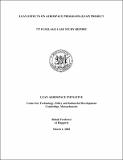Lean Effects on Aerospace Programs (LEAP) Project: 737 Fuselage Case Study Report
Author(s)
Ferdowsi, Bobak; Haggerty, Al
Download020301_Ferdowsi,Haggerty_LeanEffectsAeroPrograms.pdf (4.162Mb)
Terms of use
Metadata
Show full item recordAbstract
The Boeing 737 “Next Generation” (NG) is the follow-on to the longest continuous production line in commercial aircraft history. The original 737 (-100) was launched in February of 1965, followed by the –200, -300, -400, and –500 models, and by completion of the “Classic” Program, in 1993, 3132 737s had been delivered. The Next Generation 737 represented
a radical redesign of the aircraft, including the –600, -700, -800, -900, “Combi” (-700C), and Business Jet (BBJ) models, to be superior to competitorssuch as the Airbus A320 series and the McDonnell
Douglas MD-90. The airplane falls under Boeing Commercial Airplane Company, which is a subdivision of the Boeing Company. Customers for the aircraft include major airlines around the globe in addition to customers who use the plane for cargo, such as the United States Navy. This report will describe the program and product and an overview of the whole picture—the extended enterprise. The study will continue to look at the
implementation of lean, including highlights and achievements, enablers and practices, as well as external factors and developments. That is followed by a look at remaining challenges and future opportunities, and the paper is concluded with a section on “lessons learned” and final observations.
Date issued
2002-03-01Keywords
lean, lean enablers, Boeing 737
Collections
The following license files are associated with this item: